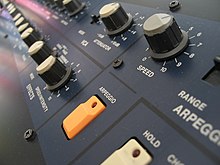Arpeggiator
An arpeggiator is a function in electronic music that creates a short, continuous sequence of tones. The term is an artificial word, based on the Italian arpeggio and again arpa , Italian for harp : In the characteristic harp playing, which was often used as an accompaniment to singing or leading instruments, a sequence of strings is usually struck.
In the 1970s, arpeggiators also appeared in home organs , where they were part of the automatic accompaniment functions : the keynote of the continuous arpeggio was selected by pressing the corresponding key in the lower manual. The analog Yamaha Electone models in particular had extensive arpeggio functions with four, six or even eight variations.
A (hardware or software) sequencer or synthesizer often has arpeggiator functions today. The recording is usually done by entering a chord , i.e. pressing several keys on the keyboard at the same time. A saved arpeggio can then be triggered like a single note, whereby the tempo, direction of play (up / down) and, if necessary, transposition (shifting the pitch) can be set.
